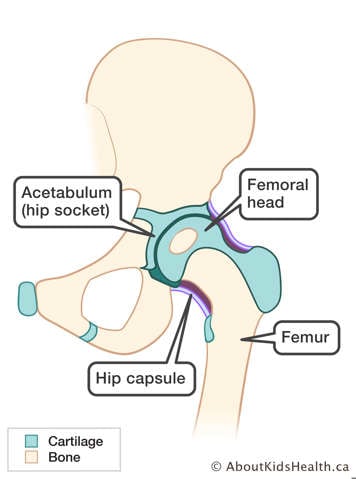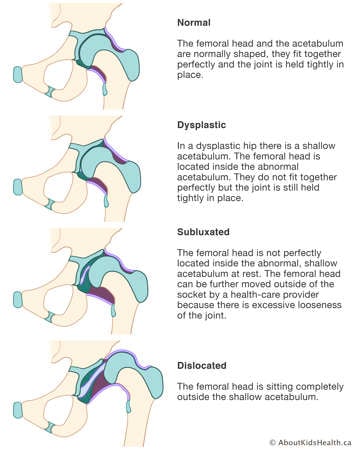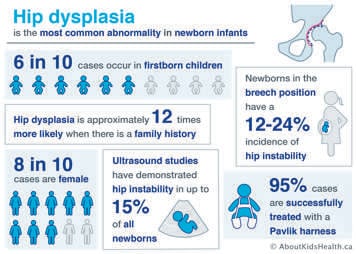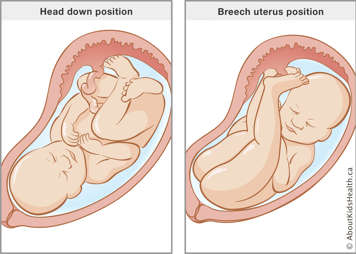What is developmental dysplasia of the hip (DDH)?
Developmental dysplasia of the hip (DDH) is a term used for babies or children who have instability of the hip joint which ranges from mild to severe. The infant or child may have general looseness of the hip (mild) or they may have a fully dislocated hip (severe). DDH is extremely common. DDH can occur in one or both hips.
- 1 in 10 infants are born with hip instability.
- 1 in 100 infants are treated for hip dysplasia.
- 1 in 500 are born with completely dislocated hips.
Hip joint anatomy
The hip joint is a "ball and socket" joint. The "ball" is the top of the femur (the thigh bone) and is called the femoral head. The "socket" is the dome shaped opening in the pelvis called the acetabulum. The femoral head is held in the acetabulum by the shape of the bones, the muscles surrounding the hip and the capsule, which is a fibrous tissue structure that holds joints in place.

Severity of DDH

In the normal hip, the femoral head and the acetabulum are normally shaped, they fit together perfectly and the joint is held tightly in place.
In a dysplastic or subluxable hip there is a shallow acetabulum. The femoral head is located inside the abnormal acetabulum. They do not fit together perfectly. In a stable dysplastic hip, the joint is held tightly in place. In a subluxable hip the femoral head can be gently moved by a health-care provider.
In a subluxable hip, there is a shallow acetabulum. The femoral head is located inside the abnormal acetabulum but can be gently moved outside of the acetabulum by a health-care provider because there is excessive looseness of the joint.
In a subluxated hip, there is a shallow acetabulum. The femoral head is not perfectly located inside the abnormal acetabulum at rest; therefore, the hip is considered unstable. The femoral head can be further moved outside of the socket by a health-care provider because there is excessive looseness of the joint.
In a dislocated hip the femoral head is sitting completely outside of the abnormally shaped shallow acetabulum; therefore, the hip is considered unstable. In some cases the femoral head can be easily moved back into the acetabulum with gentle maneuvers by the health-care provider; this is called a reducible dislocated hip. When the femoral head is moved back into the acetabulum, it may create a sound known as a "clunk". In other cases the femoral head cannot be moved back into the acetabulum by the health-care provider. This is called an irreducible dislocated hip; it is the most severe type of DDH.
Both the severity of DDH as well as the age of the infant at diagnosis will direct the treatment plan.
What are the causes of DDH?

DDH develops close to the time of birth, after birth or during childhood. The exact causes of DDH are not known. Some risk factors can increase your child’s chances of being born with DDH. These include:
- female babies (8 in 10 cases)
- firstborn babies (6 in 10 cases)
- family history of DDH
- If a child has DDH, the risk of another child having it is 6% (1 in 17).
- If a parent has DDH, the risk of a child having it is 12% (1 in 8).
- If a parent and a child have DDH, the risk of a subsequent child having DDH is 36% (1 in 3).
- breech position (when the fetus is positioned feet first or bottom first)
- decreased amniotic fluid in the womb (oligohydramnios)
- problems with the muscular or skeletal system

How is DDH diagnosed?
In Ontario, a clinical examination is used to look for DDH in babies at birth and at their well-baby check-ups by their primary care provider. Signs of DDH may be very subtle and may vary depending on the child’s age. DDH can be difficult to detect and not all cases of DDH will be picked up during these examinations. Some of the signs your primary care provider will look for include:
- an audible "clunk" during the opening and closing of the hips
- inability to move the thigh outward at the hip
- one leg shorter than the other
- unevenness in the fat folds of the thigh around the groin or buttocks
- limping or walking on the toes of one foot in older children
- a spine curve in older children
If your primary care provider is concerned about the results of the physical exam in the newborn, then they may order an ultrasound of the hips to look more closely. The child may also be referred for ultrasound if there are multiple risk factors, including being a girl, first born and born in a breech presentation. All breech babies and those with a family history of DDH should have a screening hip ultrasound at 6 weeks of age.
Referral to a specialist at SickKids
Depending on the primary care provider’s findings, the infant may be referred to a specialist clinic for further examination of the hips. When newborn babies are referred to SickKids, they are seen by an interprofessional health-care team in the one-stop Baby Hip Clinic. Walking age children are seen in one of the general orthopaedic clinics by an orthopaedic surgeon and their team.